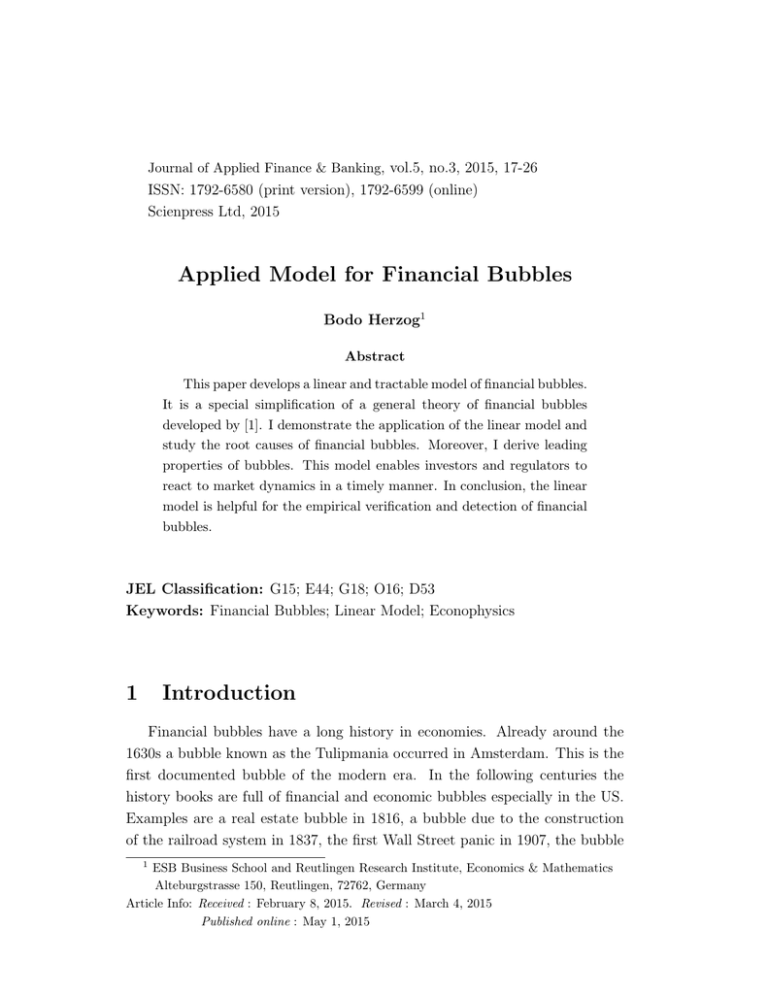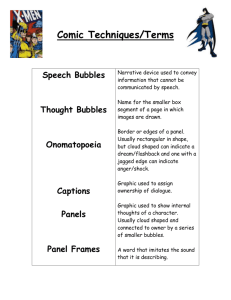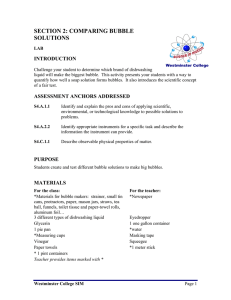Applied Model for Financial Bubbles
advertisement

Journal of Applied Finance & Banking, vol.5, no.3, 2015, 17-26 ISSN: 1792-6580 (print version), 1792-6599 (online) Scienpress Ltd, 2015 Applied Model for Financial Bubbles Bodo Herzog1 Abstract This paper develops a linear and tractable model of financial bubbles. It is a special simplification of a general theory of financial bubbles developed by [1]. I demonstrate the application of the linear model and study the root causes of financial bubbles. Moreover, I derive leading properties of bubbles. This model enables investors and regulators to react to market dynamics in a timely manner. In conclusion, the linear model is helpful for the empirical verification and detection of financial bubbles. JEL Classification: G15; E44; G18; O16; D53 Keywords: Financial Bubbles; Linear Model; Econophysics 1 Introduction Financial bubbles have a long history in economies. Already around the 1630s a bubble known as the Tulipmania occurred in Amsterdam. This is the first documented bubble of the modern era. In the following centuries the history books are full of financial and economic bubbles especially in the US. Examples are a real estate bubble in 1816, a bubble due to the construction of the railroad system in 1837, the first Wall Street panic in 1907, the bubble 1 ESB Business School and Reutlingen Research Institute, Economics & Mathematics Alteburgstrasse 150, Reutlingen, 72762, Germany Article Info: Received : February 8, 2015. Revised : March 4, 2015 Published online : May 1, 2015 18 Applied Model for Financial Bubbles and Great Crash in 1929, and finally the US-housing bubble in 2006 and the subsequent financial crisis of 2007 to 2009. No doubt, all bubbles had tremendous costs and negative externalities to the economic system. Moreover, every bubble exacerbates volatility and fragility to the financial and economic system [2]. Thus, it is of intrinsic interest to study the root causes and forces of financial bubbles today. This paper follows a newly developed interdisciplinary approach by [1]. However, this paper uses a simplification of the general non-linear mathematical theory, i.e. a linear and tractable model version. Yet this model is comprehensive enough to study the root causes and properties of financial bubbles. The ultimate goal is the study of bubble properties’ and the development of new empirical criteria for the detection of bubbles. I intent the development of an early–warning mechanism for financial bubbles in general. To my knowledge, there exists no comparable model that emphasise all the complex issues in a tractable framework for investors and regulators alike. Despite the complexity of financial markets the linear model provides relevant insights. The remainder of the paper is structured as follows. Section 2 gives a brief literature review. In Section 3, I describe the linear mathematical model and study the main implications. Finally, section 4 provides concluding remarks. 2 Literature Review A good overview about the causes of financial bubbles can be find in [3] and [4]. Both argue that speculation occur if there are new, or perceived as new, technological developments, such as trade with the new world, new infrastructure, new products, internet, etc. In this environment people tend to overestimate the effects and benefits due to new enthusiasm. The reference point of this literature is the seminal work by [5]. [6] developed in line with [3] the existing approach further in particular beyond an explanation of overreaction as an origin of bubbles. In the field of mathematical theory, [7] demonstrates an interesting mathematical idea based on stochastic and martingale theory. However, these models are all rather sophisticated and intractable for the study and detection of bubbles in reality. 19 Bodo Herzog Therefore, [1] has built a general model of financial bubbles based on a Econopyhsics and thus interdisciplinary perspective. The general model already provides intriguing insights, however, it is still too general for practical purposes in finance and regulation. Consequently, this paper utilizes the general model idea but it translates the model into business reality. First, I linearize the model without too much loss of generality but to the great benefit of tractability. Second, I study the linear model and develop empirical criteria for the detection of financial bubbles. Consequently, this paper goes beyond the economic literature in this field that is still in its infancy. 3 The Model Next I briefly describe the model in general and thereafter discuss the linearization. The asset price pi (f, t) of asset i is a function of the fundamental price, f , and time, t. Based on this idea, I define a Benefit-Loss-Rate (BLR). This is equal to the first derivative: ui = ∂pi (f, t)/∂t. The BLR can be interpreted as the change of the asset price or physically as speed. In line with physical terminology, the acceleration of the price change is given by the second derivative: ai = ∂ 2 pi (f, t)/∂t2 . In more general, I define a unique Benefit-Loss-Field (BLF) uki (p(f, t), t), that yields uki (pi (f, t), t) (1) where k captures the agents’ experience, confidence or reputation level (k H > k L ) for H as high and L as low respectively. The existence of a BLF implies that for each price process, pi (f, t), exists only one unique benefit or loss. This assumption is similar to empirical evidence in financial markets [8]. Let me next define: Definition 1: Trading volume (flow) of asset i is defined as the amount of buy or sell orders (number of trades) times the buy or sell price per day. It is denoted by the function q(p(f, t), t). Definition 2: Trading density of asset i is defined as the number of trades within a certain price range pa < pi < pb . It is denoted by ρ(p(f, t), t). 20 Applied Model for Financial Bubbles Definition 3: There exists a relationship between trading volume, trading density and the Benefit-Loss-Field, such as q(p, t) = ρ(p, t) ∗ u(p, t). (2) Based on the definitions a general model of financial bubbles can be characterized by a non-linear PDE such as ∂ρ dq ∂ρ + = 0. ∂t dρ ∂p (3) The general derivation of this equation can be studied explicitly in [1]. Obviously, solving this non-linear PDE requires further assumptions. Hence, let me assume that the BLF is depend on ρ, such as u = u(ρ), with the following properties: 1. uj (0) = ujk,max , where ujH,max > ujL,max .2 2. uj (ρmax ) = 0 3. du dρ := u0 (ρ) ≤ 0. In addition, [1] proves the existence of the following theorem: Herzog-Theorem. The general solution of equation (3), is given as ρ = g(p, t) = g(p − umax t). Proof. In [1]. Next, I use the linearized model together with an explicit function for the BLF. In the subsequent part, I discuss the implications of this simplified and explicit model. The following explicit linear function u(ρ) is inline with the previous three assumptions: umax ρ ρmax − ρ = umax 1 − . u(ρ) = ρmay ρmax (4) Substituting this linear function in equation (2), yields q = ρ ∗ u(ρ) = ρumax 1 − 2 ρ ρmax . (5) Intuitively this means the higher the reputation the greater the potential gains, and hence the BLF. 21 Bodo Herzog For finding the optimum, I compute the first-order condition that is equal to 2ρ dq = umax 1 − = 0, dρ ρmax (6) and solve it for ρ, which yields ρmax . (7) 2 Combining this with equation (5), I obtain the optimal value of the trading volume ρ∗ = ρmax ∗ umax . (8) 4 Let me define the fundamental price pF =: p̄, i.e. independent of t. Hence, I can separate the price density into two parts: q ∗ (ρ∗ ) = ρ max ρ(p, 0) = 0 if p < p̄, if p ≥ p̄. (9) Using equ. (6) together with equ. (9) yields a differential equation (ODE) for two different constellations: For ρ(p, 0) = ρmax : For ρ(p, 0) = 0 : dq dp = = −umax ⇒ p = −umax ∗ t ∀p < p̄ dρ dt dq dp = = umax ⇒ p = umax ∗ t ∀p ≥ p̄. dρ dt (10) Figure 1 illustrates the space-time diagram graphically. There, the characteristics are given by the following relationship: dq/dρ = p/t. Figure 1 illustrates the space time diagram of a financial bubble. The two areas result because of two different constellations: A) a competitive market, ρ = ρmax , i.e. full information. B) a market with asymmetric information or turmoil, i.e. ρ = 0. The latter constellation means that a few buy or sell orders have a huge impact on the market price and it leads swiftly to a bubble or crash. To determine the functional form of trading density, ρ, I combine equation (6) with (10). 22 Applied Model for Financial Bubbles Figure 1: Characteristic Functions For Different Market Situations p 2ρ = umax 1 − . t ρmax (11) I obtain a solution for ρ, as ρmax p 1− . ρ= 2 umax ∗ t (12) Equation (12) shows that financial bubbles are small if agents have higher reputation or experience. Therefore, herd behavior is more likely in a group of novices with both low reputation and experience. A market with professional traders display less herd behavior and thus works more efficiently. Figure 2 illustrates that issue graphically over two time-periods: Proposition 1. Trading density is a function of p and t and it depends on the competitiveness of markets, ρmax , and the maximum of the benefit-lossfield, umax . Proof. See equation (12) The rate of change of the asset price over time, dp/dt, is equal to the function u(f, t): dp/dt = u(f, t). Hence, I obtain the following equation for different market conditions, such as from ρ = ρmax to ρ = 0, 23 Bodo Herzog Figure 2: Characteristic Market Functions dp ρ = umax 1 − . dt ρmax (13) Substituting equ. (11) in (13), and with trivial algebra, I obtain dp 1 1 p = umax + ∗ . dt 2 2 umax ∗ t (14) This is a linear-nonhomogeneous first-order differential equation (ODE). The initial conditions that this ODE has to satisfy are t = p0 /umax and p = −p0 . This problem can be solved in many ways. Equation (14) is rewritten as dp p umax − = t, (15) dt 2 2 a nonhomogeneous equidimensional equation. The general solution of the homogeneous part of this equation is p = Bt1/2 , where B is an arbitrary constant. In addition, p = At is a particular solution if A = umax + 12 A. Hence, 2 the undetermined coefficient is A = umax . Consequently, the general solution is t p = umax t + Bt1/2 . (16) 24 Applied Model for Financial Bubbles Together with the initial condition, I determine B, such as −p0 = p0 + B[p0 /umax ]1/2 and thus I obtain B = −2p0 [umax /p0 ]1/2 = −2[p0 umax ]1/2 . Consequently, the asset price is determined by 1 p = umax t − 2[p0 umax t] 2 . (17) Finally in different market environments the asset price change over time yields 1 dp p0 umax 2 = umax − 2 . dt t (18) Proposition 2. The identification of a tipping point of a financial bubble requires dp = 0, and that is detected four times later in a stress market than dt in a full competitive market. This time delay increases with the initial asset p̄ price p and decreases with the maximal BLF umax , such as t = 4 ∗ umax . dp p̄ Proof. Use equ. (18) with the condition dt = 0. I obtain: t = 4 ∗ umax . In a nutshell: the model demonstrates that agents, i.e. investors or regulators, are already in a financial bubble, before they can notice anything. This is due to two reasons: Firstly, the time delay and secondly the difference of the individual and group (herd) perspective. Individuals have a rather subjective view. Moreover, the judgment of individuals is easily biased by behavioral mechanisms, such as the over- or underestimation, anchoring or the hold on effect. 4 Conclusion This paper attempts to explain the major developments of financial bubbles. I demonstrate a new approach to detect financial bubbles. No doubt, a financial bubble is a complex issue. However, this model makes the complexity tractable. The simplified model allows us to model market complexity without stochastic and martingale theory. In general, the model has the following advantages: First, it is simple and uniquely defines a bubble. Second, the model is derived from a general theory and explains the origins and developments of bubbles. Third, the model contains novel implications for empirical studies on Bodo Herzog 25 financial bubbles. Finally, and most importantly, this model enables investors and regulators to study bubbles in a timely manner for the first time. ACKNOWLEDGEMENTS. I thank the Editor and two anonymous referees for their helpful comments and suggestions. Research is funded by the RRI - Reutlingen Research Institute. This support is greatly appreciated. References [1] B. Herzog, An econopyhsics model of financial bubbles, Natural Science, 7(2), (2015), 55-63. [2] S. Bikhchandani and S. Sharma, Herd behavior in financial markets: A review, IMF Working Paper, 00/48, (2000), 1-33. [3] J.K. Galbraith, Savings, Investment, and Functional Efficiency: A Comparative Examination of National Financial Complexes: Comment, chapter Comment, pages 305-08. University of Michigan Press, 1997. [4] C. Kindleberger and M. Fransman, The Telecoms Boom and Bust 19962003 and the Role of Financial Markets, Journal of Evolutionary Economics, 14(4), (2004), 369-406. [5] D. Diamond and P. Dybvig, Bank Runs, Deposit Insurance, and Liquidity, Journal of Political Economy, 91, (1983), 401-409. [6] H. Hong, J. Scheinkman, and W. Xiong. Advisors and asset prices: A model of the origins of bubbles, Journal of Financial Economics, 89(2), (2008), 268-287. [7] P. Protter, A Mathematical Theory of Financial Bubbles, ParisPrinceton, Lecture Notes in Mathematical Finance, Lecture Notes in Mathematics, Springer, 2081, (2014), 1-108. 26 Applied Model for Financial Bubbles [8] J.L. McCauley, Dynamcis of Markets: Econophysics and Finance, Cambridge Universtiy Press, 2004.





